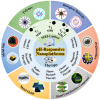Recent development of pH-responsive theranostic nanoplatforms for magnetic resonance imaging-guided cancer therapy
- PMID: 37933379
- PMCID: PMC10624388
- DOI: 10.1002/EXP.20220002
Recent development of pH-responsive theranostic nanoplatforms for magnetic resonance imaging-guided cancer therapy
Abstract
The acidic characteristic of the tumor site is one of the most well-known features and provides a series of opportunities for cancer-specific theranostic strategies. In this regard, pH-responsive theranostic nanoplatforms that integrate diagnostic and therapeutic capabilities are highly developed. The fluidity of the tumor microenvironment (TME), with its temporal and spatial heterogeneities, makes noninvasive molecular magnetic resonance imaging (MRI) technology very desirable for imaging TME constituents and developing MRI-guided theranostic nanoplatforms for tumor-specific treatments. Therefore, various MRI-based theranostic strategies which employ assorted therapeutic modes have been drawn up for more efficient cancer therapy through the raised local concentration of therapeutic agents in pathological tissues. In this review, we summarize the pH-responsive mechanisms of organic components (including polymers, biological molecules, and organosilicas) as well as inorganic components (including metal coordination compounds, metal oxides, and metal salts) of theranostic nanoplatforms. Furthermore, we review the designs and applications of pH-responsive theranostic nanoplatforms for the diagnosis and treatment of cancer. In addition, the challenges and prospects in developing theranostic nanoplatforms with pH-responsiveness for cancer diagnosis and therapy are discussed.
Keywords: MRI‐guided; cancer therapy; nanoplatform; pH‐responsive.
© 2023 The Authors. Exploration published by Henan University and John Wiley & Sons Australia, Ltd.
Conflict of interest statement
The authors declare no conflict of interest.
Figures











References
-
- Cheng L., Wang C., Feng L., Yang K., Liu Z., Chem. Rev. 2014, 114, 10869. - PubMed
-
- Zhu L., Wang D., Wei X., Zhu X., Li J., Tu C., Su Y., Wu J., Zhu B., Yan D., J. Controlled Release 2013, 169, 228. - PubMed
-
- Zhang S., Qian X., Zhang L., Peng W., Chen Y., Nanoscale 2015, 7, 7632. - PubMed
-
- Zhang L., Yang Z., Zhu W., Ye Z., Yu Y., Xu Z., Ren J., Li P., ACS Biomater. Sci. Eng. 2017, 3, 1690. - PubMed
Publication types
LinkOut - more resources
Full Text Sources
